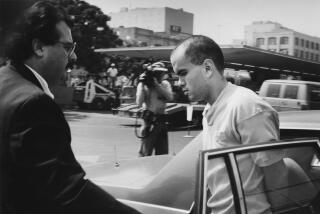Police Re-Enact Fatal Carjacking to Find Suspect : Crime: Police film a dramatization of a Chatsworth man’s slaying and ask TV stations to show it on their news shows. The tactic is criticized.
The police were stymied.
They had a murder victim, five witnesses, an offer of a $40,000 reward--and no suspect.
So they did what any red-blooded, television-watching Americans would do: They staged a re-enactment of the crime--the carjack slaying of Chatsworth resident Naghi Ghoraishy--and invited the media.
“A lot of crimes have been solved through re-enactments” on television shows like ‘Unsolved Mysteries’ and ‘America’s Most Wanted,’ said Capt. Vance Proctor of the Los Angeles Police Department’s Northridge-based Devonshire Division. “We’re hoping it will work as well for us as it does for them.”
Monday’s use of the technique--a first for the LAPD--was praised by police and the producers of tabloid TV shows.
“We’ve heard of production companies imitating ‘Unsolved Mysteries,’ but this is the first we’ve heard of a police department doing it,” said John Cosgrove, who produces “Unsolved Mysteries” for NBC. “In a way, it’s a pat on the back.”
But critics say it inappropriately makes journalists a part of the law enforcement process, and could lead to harassment of people who look like the actor who played Ghoraishy’s murderer.
The decision to borrow the crook-catching formula of reality-based TV shows is part of the Police Department’s new focus under Chief Willie L. Williams on involving the community in police work, said Cmdr. David Gascon, head of the LAPD’s Community Affairs Group. It comes on the heels of regular participation by the department in televised crime shows such as “L. A.’s Most Wanted” and others, he said.
And while the department has staged re-enactments before, Monday’s event marked the first time that the Police Department bypassed the crime shows and appealed directly to TV stations to run the dramatization on the evening news, said Lt. John Dunkin.
If it works, said Dunkin, who coordinates the department’s interaction with TV programs and other media, residents can expect to see more.
“If we get results, it is something that we would not hesitate to employ,” Dunkin said. Going to the scene of a crime and doing a dramatic re-enactment, he said, is much more effective than holding a news conference in a sterile roll-call room at police headquarters.
The idea, according to Dunkin, is to show the scene on TV to jog the memories of passersby or others who might have knowledge about the crime.
In the scene filmed Monday, a black police officer played the suspect and a white officer played the victim. It was staged at the same Mobil Oil station in Chatsworth where Ghoraishy was accosted and shot on the morning of March 15. Officers used the victim’s own car.
Officer Ralph Ward, who played the suspect, ran onto the Mobil station’s parking lot as Detective Russ Lyons, who played Ghoraishy, paid for his gas and returned to the dead man’s gold Mercedes-Benz. They struggled, Ward pulled out a gun and Lyons fell as if dead onto the pavement. Ward drove off in the Mercedes.
Ghoraishy’s daughter, Meece, was also on hand, and tearfully pleaded with viewers to come forward with information leading to the capture of her father’s killer.
Watching the scene re-enacted, she told reporters, was “like a stabbing in your heart, over and over.”
The LAPD’s Dunkin said he did not think it unseemly to borrow a technique from tabloid television shows.
“That would be like us not using computers because somebody else invented computers,” he said. “We look at things happening in society around us and if we can apply them to police work, we’ll do that--as long as it’s legal and aboveboard.”
But George Gerbner, dean emeritus of the Annenberg School of Communications at the University of Pennsylvania, said that airing the segment is likely to provoke a rash of accusations against young black men who look like the officer who portrayed the suspect.
“This is an unusual, and I would say, highly questionable tactic, and it certainly ignores the civil rights of people who resemble the actor in the re-enactment,” Gerbner said. “People who resemble the actor are going to be harassed and in a sense intimidated by this type of publicity.”
Further, Gerbner said, the TV stations that air the footage will be neglecting their responsibilities as journalists.
“The notion that journalists are engaged in law enforcement and the apprehension of suspects is a dangerous one,” he said. “That’s not their job.”
But Detective Sal Gallegos, who is handling the investigation of Ghoraishy’s death, said all he’s concerned about is finding the killer. Without more information, the investigation will remain where it is: stuck without suspects or enough significant clues.
“That overshadows everything,” Gallegos said. “I need help.”
More to Read
Sign up for Essential California
The most important California stories and recommendations in your inbox every morning.
You may occasionally receive promotional content from the Los Angeles Times.










